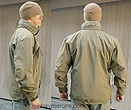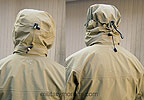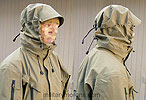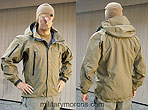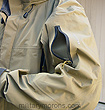As a sizing reference: I'm 5'7", 155 lbs (yeah, I'm a little guy), medium build (BDU top medium/regular, BDU pant medium/short), waist 32", chest 43". Keep this in mind when you read my comments with respect to sizing, so you have an idea of how the garments featured below will fit on you. ALL garments in these pages are size Medium, unless stated otherwise.
TO VIEW FULL SIZE IMAGES: USERNAME and PASSWORD are both "mm"
ARC'TERYX LEAF (Law Enforcement and Armed Forces) Products
Note that the product line is subject to change - some of the items below may be discontinued or changed from the time the review is written.
| 4/23/05 -
Vancouver, BC, Canada-based Arc'teryx
is a well-known name in the outdoor world, producing the latest, high-end
outdoor clothing, gear and accessories. Up till only a few years ago,
military clothing technology has usually been a step behind what's
been available on the civilian market. It makes sense that leading
manufacturers of 'technical' outdoor clothing are entering the military
market but it's more complicated than just producing civilian clothing
in 'military' colours. The Arc'teryx
LEAF (Law Enforcement and Armed Forces) Purchase Program makes
special versions of their product line available to military and LE
professionals.
|
| Alpha Jacket - The Alpha Jacket shown below is a lightweight, feature-laden waterproof hard shell with stowable hood. The colour featured here is Arc'teryx's 'Crododile', which is an olive drab/khaki shade, depending on whose colour you compare it to. It also comes in black. The main shell material is MI270 Gore-Tex® XCR®, which is a 3 layer fabric with great tear strength and abrasion resistance with a DWR finish for water repellency. Note that the DWR (water repellant treatment) will have to be 'renewed' after some time, with a spray-on or wash-in treatment . The Alpha is sized more generously than the Bravo or
Combat jackets and will fit over my PCU Level 3 high-loft pullover,
or over the Bravo jacket (which I found provides comparable insulation
to a PCU Level 2 long-sleeved shirt). Another reason for the looser
fit is that it's non-stretchable, so a bit more room is provided in
the right places to allow for freedom of movement without the jacket
being pulled. The extra room can be found in the shoulders, articulated
elbows and under the arms. The elbows have enough room such that bending
the arm doesn't pull the cuff back. In fact, I found that the the
Crye Combat Shirt with integral elbow pads would fit under the Alpha
jacket. The 14" water-resistant pit zips under the arms can be opened up from either end for ventilation. The cord zipper pulls have rubber shrink wrap on them to make them easier to locate and pull, especially with gloves. The sleeve cuffs have a slightly stiff, low-profile laminated velcro tab adjuster, which is very easy to use, secure, and forms a tight seal. The one-way main zipper in the front of the jacket is protected by a storm flap, which secures with small, round velcro patches, and snaps at the top and bottom.
When not in use, the hood is folded and stowed inside the zippered, full size compartment that runs the length of the collar. This of course, adds some bulk and stiffness to the collar, but I found that it really doesn't get in the way, as it tends to stand off away from the neck and face. The hood itself is by far the best I've ever used. It's large enough to fit over a helmet (I put it on over my Canadian Gallet), and is completely adjustable for use under a helmet or with no headgear at all. Adjustments are made via shock-cord pulls with cord-locks. The size of the hood opening is adjusted by pulling down on the two pull-tabs located on each side of the neck at the base of the collar. Pulling on the upper tab in the back of the head adjusts the circumference around the temples, so you have unhindered peripheral vision. The lower tab at the base of the skull pulls the upper tab backwards and down towards the neck, which snugs up the hood and also affects the ride height of the semi-stiff brim. The combination of these adjustments allow me to configure the hood exactly how I want it. No military Gore-Tex jacket hood should be without these features.
The upper arm pocket compartments are about 6"x7", with a 6" water-resistant zipper opening with cord pull. The side-entry hand pocket compartments are 10" tall, and 9" wide at the top, tapering to 7" wide at the bottom. The 9" zipper opening has a molded 'zipper garage' at the top, into which the zipper 'parks' when closed. The hand zippers have rubber wrapped cord pulls. On the inside, a laminated stretch-fabric pocket is located below the chest on each side, for smaller, flat items. Like the other Arc'teryx garments on this page, all the pockets are characteristically low profile and unobtrusive.
The bottom of the jacket has shock-cord waist adjusters, which can be pulled with one hand. Looking inside the jacket, all seams are taped, sealed, and reinforced. The jacket is relatively light weight for a hard shell and compresses into a small enough package to stuff into a medium Kifaru pullout (about the size of a full 50oz camelbak bladder). The typical Arc'teryx attention to quality and detail is apparent from the very neat, high-count stitching and various features.
|
Arc'teryx LEAF Alpha LT Jacket
| 12/18/09 - Another new item from the LEAF (Law Enforcement and Armed Forces) division of Arc'teryx is the Alpha LT Jacket. The Gore-Tex Pro Shell Alpha LT isn't simply a lighter version of the Alpha, but more of a very advanced, light weight, Alpine wind shirt that's designed to provide full weather protection in a very packable garment. It was adapted from the civilian line Alpha LT with a change of colour (Crocodile) for the LEAF line, and abounds with high-tech construction features. Material - The Alpha LT is made from Gore-Tex® 3L Pro, which is a three-layer laminate consisting of a face fabric, the Gore-Tex® membrane, and a Gore Micro Grid backing fabric. It's engineered to excel in extended/extreme conditions while being tough, breathable, waterproof and wind proof. The Micro Grid backer is a thin, low-denier, low-density woven fabric that allows the shell to slide easily over mid layers. It also improves internal abrasion and snag resistance, enhances breathability and decreases garment weight. Compared to the Alpha Jacket, which is made of MI270 Gore-Tex® XCR®, the Alpha LT fabric has a smoother face, feels lighter and more supple, and has less of a 'crinkly' sound when moving. It still has the typical nylon 'swish' sound when moving. There is a very slight hue difference between the Alpha and Alpha LT material. The Alpha LT is ever so slightly greener. Here's a summary of the features on the Alpha LT Jacket, size medium shown:
Sizing, fit etc - The Alpha LT fits me the same as the Alpha Jacket - which means that my size medium has enough room for a relatively thick mid layer underneath. The Atom Lt jacket featured above is the perfect jacket liner for the Alpha LT, as it's form fitting and very light. The Gore-Tex 3L Pro isn't stretchy, so a bit more room is provided in the right places to allow for freedom of movement without the jacket being pulled. The extra room can be found in the shoulders and articulated elbows. The gusseted underarms prevent the cuffs from riding up when lifting the arms over the head. General notes and observations - The Alpha LT is referred to as a 'Level 6' garment, which in the SOF-PCU clothing system corresponds to the water proof rain suit. The Alpha LT really isn't just a lighter weight version of the Alpha jacket; there are also design/feature differences that have optimized it for light weight and packability. It is also more technologically advanced. The hood on the Alpha stows while the Alpha LT hood doesn't, and the arm pockets amd velcro of the Alpha are not present on the Alpha LT. While the Alpha isn't bulky, it's twice the weight of the Alpha LT and not as packable. The Alpha LT will fold down into approximately the volume of a USGI 1-quart canteen. Besides the lighter fabric, it achieves this through choice of components (lighter and more pliable water proof zippers, narrower seam tape, mini cord locks etc) and advanced construction technology (extensive use of welded seam and micro seams). This is one of the most technologically advanced garments I've seen, and it's only apparent upon close examination. Wherever possible, stitching has been eliminated in favour of welding and lamination. The micro seam allowance is a trip. When I examined the Alpha LT closely to see what this meant, I realized that there was no exposed stitching at the seams! Typically, I'll see Arc'teryx's very tight stitching joining the separate panels of the garment together. On the Alpha LT, there isn't any exposed thread to be seen. Instead of overlapping material and stitching it together with thread visible on the outside; on the LT, the two pieces of fabric are sewn together on the inside with a tiny seam allowance, and covered on the inside with seam tape, creating a very flat and non-bulky seam. So, from the outside, no threads are visible, which also means that they're not exposed to abrasion. All you can see is the parting line, and a hint of stitching underneath. See the photo below comparing the Alpha Jacket on the left and the Alpha LT on the right: The closer I examined the Alpha LT, the more I appreciated the details and technology that go into it. In my informal sink test, the Gore-Tex 3L Pro proved to be water proof - I wouldn't have expected anything different. I lined the sink with the Alpha LT and filled it up with as much water as I could, and left it for more than 24 hours. Water drops on the surface of the fabric beaded up and run off, as the water-repellant treatment (DWR) was still new, but when soaked for a long period along with pressure, the face fabric absorbed some water, which is to be expected. No water penetrated the Gore-Tex membrane, and the inside was dry, which is what counts. The face fabric dried very quickly, as it's very thin and can't hold much moisture. Like other Gore-tex fabrics, the DWR can be renewed with a spray-on renewer (I avoid wash-in as I have no control over where the DWR goes). I've found that in general, the DWR on most hard and soft shells will eventually wear and need renewing, especially on the shoulders and hood. The hood is very quick and easy to adjust. It's pretty amazing that a hood that is large enough to fit over a helmet can be adjusted down to give you a 'ninja slit' with barely more than my eyes showing. By cinching the adjustments down, I can snug the hood on my head enough so that it moves with my head, instead of my head moving inside it. Except at the extreme ranges of travel at each side, the hood can rotate enough to give me more than 180° of unrestricted vision. While the Alpha LT is not an insulated garment, it definitely provides some warmth from trapped body heat. The Alpha Jacket probably has the slight edge in durability, solely based on the thickness of the fabric, and has more load-carrying capability and features like the stowable hood. I see the Alpha Jacket used when wet and cold weather is a certainty, where it is worn most of the time and the extra storage in the shoulder pockets is needed. The role of the Alpha LT, as I see it, is as a garment that is compact and light enough to be packed or carried until it's needed for protection from the elements. It's light and compact enough to be brought along at the mere chance of adverse weather, where bringing a heavier garment might be cause for hesitation due to weight and size. The combination of the super-compressible Atom LT jacket/liner featured above and the Alpha LT are a great choice for covering a wide range of temperature and weather conditions when weight and packability are main concerns. |
Arc'teryx LEAF Gryphon Halfshell
| 8/24/10 - The Gryphon Halfshell is a new offering from the LEAF (Law Enforcement and Armed Forces) division of Arc'teryx. The Gryphon is part of LEAF's new Armour Compatible Layering system. Aptly named after the legendary creature that was a hybrid of a lion and and eagle, the Gryphon is a 1/4-zip, non-insulated pullover hybrid hooded anorak that utilizes softshell fabric in areas that are covered by body armour and hardshell fabric in high-exposure areas like the shoulders and sleeves. It is designed to be armour-compatible. The Gryphon also incorporates Arc'teryx's 'Roll-and-Stow' sleeve system that enables the user to convert the sleeve configuration on the go from long to short during periods of intense physical activity. Armour Compatible Layering - Arc'teryx's armour-compatible garments are designed to work as part of a synergistic system that includes body armour and gear as part of the layering system. By including armour as part of the system, Arc'teryx created a series of products to work in conjunction with the gear, that increases comfort, performance and versatility across a wide range of activities and environments. Two of the most distinctive features is the use of hybrid construction (soft and hard shell textile combinations), and their Roll-and-Stow sleeve system. The hybrid construction of the Gryphon provides weather-resistant protection for the user, while the stowable sleeves allow a greater range of operating temperatures for the jacket and aids in cooling the user down after hard extertion without having to take off the jacket and armour. The rolled up sleeve store underneath the shoulder pockets, leaving nothing exposed to snag. The separate shoulders, which lay on top of the sleeves give the Gryphon a very distinctive look. Origin/Development - Now, some readers will probably say 'Haven't I seen a similar concept like this before in the OTTE Gear DK Hybrid Jacket?' Commercially, yes. However, the Gryphon jacket concept started out as the result of a series of conversations with a particular military unit, which started back in early 2007 with operational testing beginning that fall. The current configuration of the Gryphon you see here is the result of feedback on over 50 OCONUS deployed samples, and is actually the 4th generation of this design . None of the previous three versions were offered commercially, which is why they remained sight unseen. The lineage of the hybrid fabric construction of the Gryphon actually comes from the commercial Arc'teryx Alpha Comp Hoody in 2007 (no longer available), with its hybrid hard/soft shell construction. Material - The Gryphon utilizes three fabrics in its construction (Crocodile shown here): Tweave® Durastretch 520e for the Torso and sleeve pockets - A technical stretch woven with 92% nylon and 8% lycra spandex. Durastretch is a durable, abrasion resistant, water and wind resistant, low-bulk, breathable fabric with excellent stretch and recovery properties. The Multi-directional (4-way) permanent-stretch spandex has 100% memory for shape retention. The Tweave Duratretch used for the Gryphon is not laminated to a lining fabric - it is a single layer material. It is designed as a breathable shell material for wind and moisture resistance than an insulating material. This means that it can be used in warmer temperatures, and is very packable. It is treated with a DWR (durable water repellant). This is the same fabric used for the Arc'teryx Combat jacket and pants. MI270 Gore-Tex® XCR® for the Shoulder yoke and sleeves - XCR is a 3 layer fabric with great tear strength and abrasion resistance with a DWR finish for water repellency. It is the fabric used for the Alpha Jacket and bib, and is engineered to excel in extended/extreme conditions while being tough, breathable, waterproof and wind proof. Gore-Tex® XCR® has 25% less resistance to moisture vapour transmission than Classic Gore-Tex which means that you stay drier inside. The fabric has a DWR finish for water repellency. Note that the DWR (water repellant treatment) will have to be 'renewed' after some time, with a spray-on or wash-in treatment. I prefer the spray-on treatments. Gore-Tex® 3L Pro Shell for the hood - Pro-shell is a three-layer laminate consisting of a face fabric, the Gore-Tex® membrane, and a Gore Micro Grid backing fabric. It's the same material used for the Alpha LT jacket, and is lighter and more packable than XCR, hence the choice for the hood. The Micro Grid backer is a thin, low-denier, low-density woven fabric that allows the shell to slide easily over mid layers. It also improves internal abrasion and snag resistance, enhances breathability and decreases garment weight. Here's a summary of the features on the Gryphon Half-shell Jacket, size medium in Crocodile shown (also availabe in black):
Sizing, fit etc - The Gryphon feels like it fits exactly like the Arc'teryx Combat Jacket on me. I zipped up my Combat Jacket and donned it over my head like an anorak, then did this with the Gryphon. Both felt the same going on and coming off, and while being worn. This means that the Gryphon has what Arc'Teryx refers to as 'athletic patterning', which in this case means 'more form fitting but unrestrictive' - maybe with a bit more room around the shoulders and chest with a slimmer waist. It's not at all tight on me, nor baggy either. The torso tapers towards the waist, and the Tweave fabric is stretchy enough to make donning it over the head easy, and has low enough bulk to be tucked into the pants. Once on, the Gryphon is very comfortable and non-restrictive. There's ample room in the sleeves, as well. The gusseted underarms prevent the cuffs from riding up when lifting the arms over the head. General notes and observations - The Gryphon Halfshell is categorized as a 'Level 6' garment, which in the SOF-PCU clothing system corresponds to the water proof rain suit. It's more of a Level 5/6, due to the hybrid fabrics used in its construction. As mentioned above, the Gryphon was designed to be part of a combat gear system; rather than just a weather-resistant garment designed without consideration for use under gear. The lack of features on the torso, and the breathable soft-shell fabric make the Gryphon a very comfortable garment to be worn under armour or a pack. The hard shell fabric is placed on areas of the jacket that are exposed, and not covered by armour. With the sleeves worn down, the Gryphon is very similar in weight and comfort range to that of the Combat Jacket, which was designed a technical alternative to the standard BDU top in cooler conditions, but more hard wearing, water and wind resistant, abrasion and tear-resistant, and more versatile. The Gryphon can also be worn alone like a BDU top ( over a thin base layer/t-shirt) or as part of a layering system. It's really no more bulky than an enhanced BDU top with shoulder pockets etc, so it's possible to wear it under other jackets if need be. It also packs down to about the same size, and can be stuffed in a pack without issue. Of course, the Gryphon can be worn without armour or gear as a stand-alone wind shirt or rain shell. With the sleeves rolled up, the Gryphon can be worn in warmer temperatures than the Combat Jacket, and also allow more ventilation/cooling under exertion.
The roll and stow sleeve system works very well, and the method of conversion and stowage is quite elegant (it's patent pending). Stowed under the shoulder pocket 'bell', nothing is left to flop around, snag or come loose. You don't really notice the rolled up sleeves, and the under arm loop keeps the shoulder bells stable on the arm. Some guys with big arms may find the loops a bit tight, but that's no different from other form-fitting Arc'teryx tops like the Bravo jacket. The shoulder pockets remain fully accessible and functional with the sleeves up or down. It took a little bit of practice to roll and stow the sleeves up, but it becomes easy enough after a few times. Same thing with stowing the hood. As mentioned above, I'd have liked the small round velcro patches on the hood cover to be a bit larger so they're less likely to come unstuck unintentionally. I don't always line them up perfectly when rolling the hood up and securing the cover by feel, without taking the jacket off, so having larger patches will leave more margin for error when lining them up. Or, snaps would be good as well, just like the ones used to secure the shoulder pockets to the arms. The weather has been warm during the day (being summer), and dry, so I have not yet used the Gryphon out in the rain with armour at the time of this writing. We did get some June gloom and damp rainy mornings, and while not much of a test, I did wear the Gryphon out whenever I had a chance. Based on the fabrics, I expect it to perform somewhere between the Combat Jacket and Alpha Jacket, with respect to water resistance. With all the zippers closed, it does provide some warmth from trapped body heat. Light rain had no effect on it, which was to be expected. I also wore it out in the desert to try it in the heat, both when it was hot (with the sleeves rolled up) and later with the sleeves rolled down when the temperature dropped after the sun went down. It makes quite a difference, having the sleeves up or down; just like wearing a t-shirt vs. a long sleeved t-shirt in warm weather. I was surprised that I didn't immediately boil in it, as temps were in the 90°F range. It was about the same as how a BDU top feels. You probably wouldn't need the Gryphon if it's hot and dry, but I just wanted to see how effective the sleeves were, up and down.
Where the Gryphon will shine is in wet and slightly cooler weather, where it will have a distinct advantage over a standard BDU top or non-weather resistant garment. While the hard shell material is water proof, the soft shell torso is not water proof, but highly water resistant. The DWR sheds water and it'll take a while for the material to let water through. When it does get wet, however, it dries much faster than a BDU, and doesn't hold as much water weight. If you've been immersed completely in water with BDUs, you know how heavy and sluggish waterlogged BDUs can feel when you come out of the water dripping wet. Like the Combat Jacket, the Gryphon will feel lighter and dry much faster. Like all other Arc'teryx garments in the LEAF line, the Gryphon lives up to the standard of innovation, quality and functionality that we've come to expect. Update 10/19/10 - Okay, it's fall now and we've had some rainy weather. I've worn the Gryphon around the neighbourhood in the rain, as well as on a drizzly, misty evening/night shoot. In heavier rain, the torso will get wet after a while of repelling the rain, but as I mentioned before, stays light weight and dries quickly. In drizzle and light rain, it kept me dry with armour on. I wore it over the Atom LT jacket, which kept me warm and didn't add much bulk.
|
ATTENTION! PLEASE DO NOT LINK DIRECTLY TO MY IMAGES
-
IT RESULTS IN MY BANDWIDTH ALLOCATIONS BEING EXCEEDED,
AND MY PAGES GO DOWN. THANKS!
/ . PLEASE
OBSERVE AND RESPECT OUR COPYRIGHT! . /
©opyright by MilitaryMorons.com. All Rights Reserved. Reproduction, Duplication,
Distribution Strictly Prohibited.
Unless mentioned otherwise, content and images are the
property of militarymorons.com and are not in the public domain.
They are not to be used without
permission. Please Contact
me for permission to use any images or content herein.

